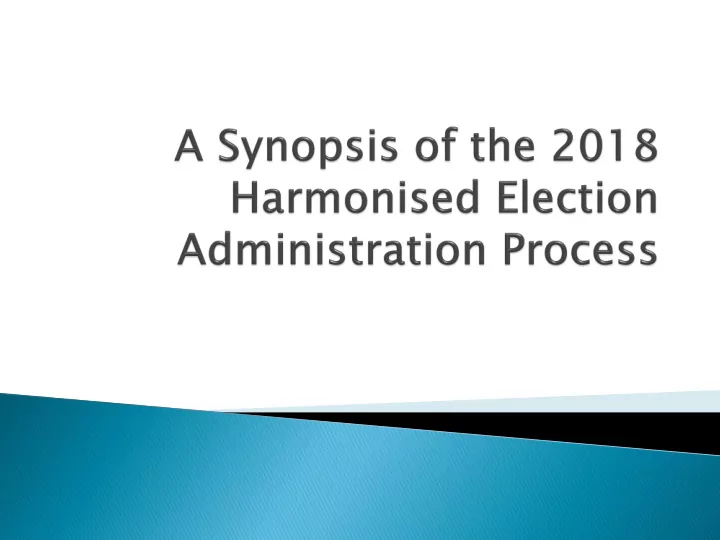

The Zimbabwe Electoral Commission has presided over three (3) harmonised elections since its inception. Its independence is guaranteed by the Constitution of Zimbabwe Its mandate is to prepare, conduct and supervise elections and referendums in accordance with the laws of Zimbabwe
Pr Presentation esentation Outline ine Legal Framework i) ii) Voter Education iii) Voter Registration iv) Multi-party Liaison and Stakeholder Engagement v) Polling vi) Results Management
Following the proclamation of the Election by the President, the election was conducted on 30 July 2018. The legal framework was supportive of all the electoral activities in 2018 Some of the key issues sues in the legal framework for 2018 Elections were electoral ectoral amendments ndments such ch as: i) Section 22A of the Electoral Act which allowed the commission to establish more polling stations. This enabled ZEC to go polling station specific voting and to create more polling stations in order to decongest polling stations that had more than 1000 registered voters – speeded up voting ii) Section 32 of the Electoral Act empowered ZEC to remove duplicates from the Voters’ roll
Section 59 of the Electoral Act allowed visually impaired iii) voters to be assisted by a person of their choice without the Presiding Officer necessarily being present To improve accountability of ballot papers, and iv) confidence, Section 52A provided for the printing of ballot papers not exceeding 10% of the number of registered voters according to internationally accepted practice. The code of conduct which was previously for political v) parties only was improved to cover all stakeholders. Section 5 – ensures that gender is mainstreamed into vi) electoral processes. This amendment obligated the Commission to advocate for regulations to ensure that women have fair opportunities to campaign and register to vote, and are thus protected from among other vices election-related violations. It also requires the Commission to provide adequate, accurate, gender sensitive and unbiased education;
While the legal framework was considered adequate, - stakeholders viewed PO POSA SA and d AIPPA PPA as restrictive to some freedoms and Political Rights The need for the alignment of the Constitution and the Electoral Act became topical especially given the conflicts in some areas – the case of the Diaspora Vote, Prisoners and the hospitalised
Voter Education was largely a success. The collaboration between ZEC and CSOs was a major milestone - 47 CSOs were accredited to conduct voter education The due regard for all native languages in all voter education materials was observed The use of both print and electronic media was commended by stakeholders Inclusion of PWDs was commendable Gender sensitive voter education was carried out. The establishment of a call centre was instrumental in ensuring communication between ZEC and its stakeholders
ZEC successfully introduced Biometric Voter Registration for the 2018 elections leading to the production of a clean new voters’ roll. The voters’ roll enhanced confidence among the electorate Over 80% of eligible voters registered The registration by the youths and women demonstrated a new appeal for participation in electoral processes
ZEC did a lot to produce a voters’ roll for the election given some litigation around the procurement of BVR materials. Within 6 months ZEC managed to register and produce a voters’ roll despite all odds Politicians hijacked the BVR process and this somehow presented challenges in producing the voters’ roll. Pre -commissioned affidavits in a bid to beat proof of residence dilemmas became an issue. Stakeholders continue to question the requirement for Proof of Residence although ZEC is allowed to make further recommendation for reforms in this respect
ZEC managed to engage its stakeholders throughout the process. Stakeholder engagements took place at Head Office, Provincial and District level The constant interactions helped to diffuse tension and clear certain misconceptions Political tensions and lack of tolerance led to abandoned interactions at Head Office level. The need for stiffer penalties for political violence need to be considered.
10 985 polling stations were established. Polling was successfully conducted, peacefully and all eligible voters managed to exercise their democratic right as confirmed by most observers Composite polling stations however resulted in several people being redirected.
Results Management entails the production of the V11 and the collation of those polling stations returns at Ward Centres. Transmission from polling station to ward, to constituency centre, to district centre, to province and to the National Results centre is a process. In as much as ZEC adopted two transmission routes, the collation itself was overwhelmed by the number of candidates in the tripartite election. There was an overwhelming amount of contesting candidates in some urban constituencies.
For instance, in Pumula Constituency, there were 21 MP contestants, 17 Councillor contestants in one ward and 23 Presidential contestants. In this case, the presiding officer was supposed to produce 61 V11 forms for Polling Agents, 3 to be posted outside, 4 given to Observers and the Media besides the ZEC Official copies . The above scenario meant a lot of work for our electoral officials at polling stations. The problem escalated to the ward and constituency centres. Despite this huge amount of work, ZEC managed to announce the results in time.
ZEC cannot rule out the need to continuously improve the Results Management System. ZEC is looking at modalities for an effective Results Management System which embraces both technology and Real-time Transmission.
Recommend
More recommend